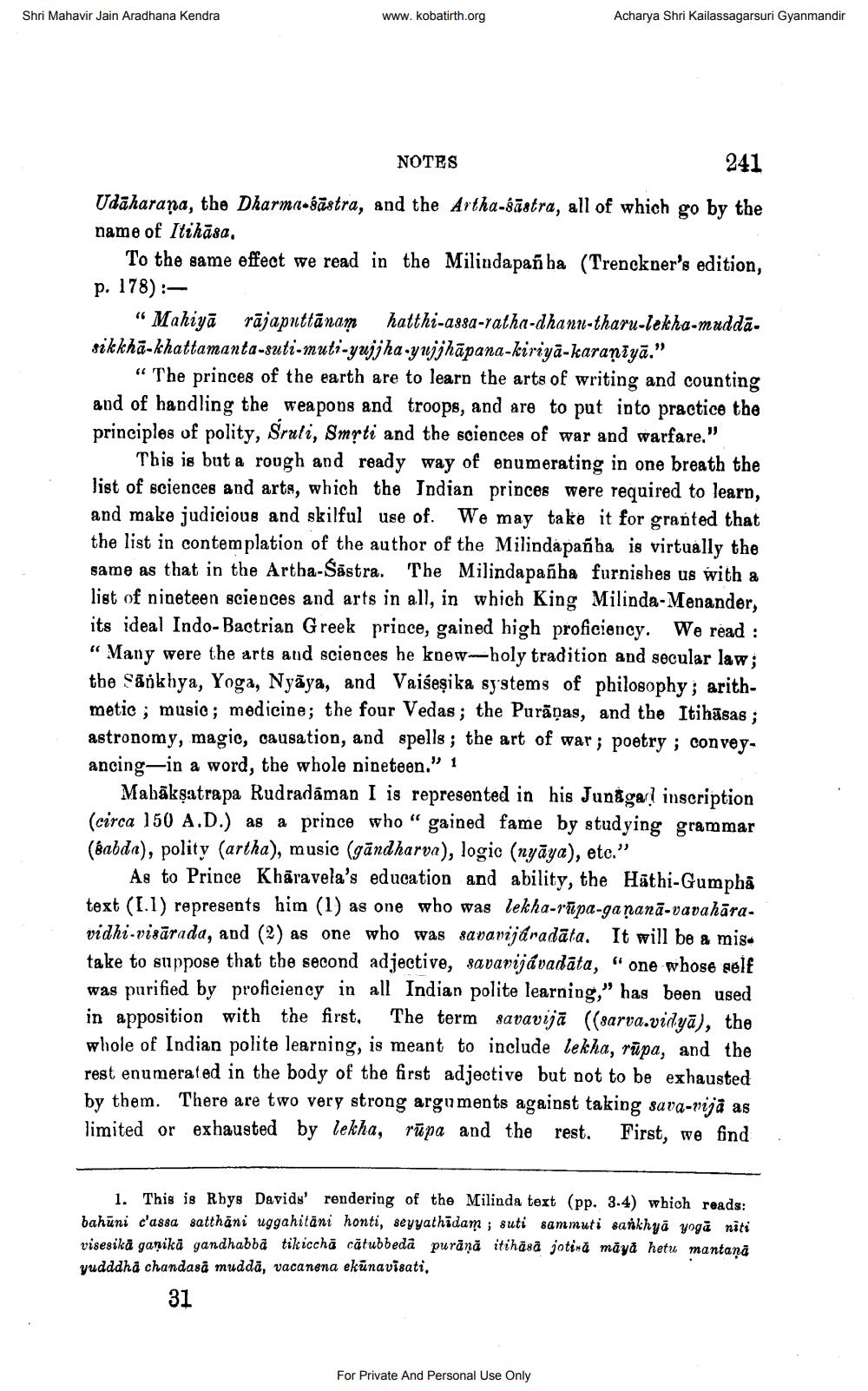________________
Shri Mahavir Jain Aradhana Kendra
www.kobatirth.org
Acharya Shri Kailassagarsuri Gyanmandir
NOTES
241
Udaharana, the Dharma-gāstra, and the Artha-śāstra, all of which go by the name of Itihāsa,
To the same effect we read in the Milindapañ ba (Trenckner's edition, p. 178) :
“Mahiyā rājaputtānam hatthi-assa-ratha-dhanu-tharu-lekha-muddasikkha-khattamanta-suti-muti-yujjha-yujjhāpana-kiriya-karaṇīyā."
“ The princes of the earth are to learn the arts of writing and counting and of handling the weapons and troops, and are to put into practice the principles of polity, Srali, Smrti and the sciences of war and warfare."
This is but a rough and ready way of enumerating in one breath the list of sciences and arts, which the Indian princes were required to learn, and make judicious and skilful use of. We may take it for granted that the list in contemplation of the author of the Milindapañha is virtually the same as that in the Artha-Šāstra. The Milindapanha furnishes us with a list of nineteen sciences and arts in all, in which King Milinda-Menander, its ideal Indo-Bactrian Greek prince, gained high proficiency. We read : “ Many were the arts and sciences he knew-holy tradition and secular law; the Sankhya, Yoga, Nyāya, and Vaišeşika systems of philosophy, arithmetic ; musio; medicine; the four Vedas; the Purāṇas, and the Itihāsas; astronomy, magic, causation, and spells ; the art of war; poetry ; conveyancing—in a word, the whole nineteen." 1
Mabākṣatrapa Rudradāman I is represented in his Jundgari inscription (circa 150 A.D.) as a prince who “gained fame by studying grammar (sabda), polity (artha), music (gāndharva), logic (nyāya), etc."
As to Prince Khāravela's education and ability, the Hāthi-Gumpha text (1.1) represents him (1) as one who was lekha-rūpa-gananā-vavahāra. vidhi-visārada, and (2) as one who was savavijáradāta. It will be a mis. take to suppose that the second adjective, savavijávadāta, "one whose self was purified by proficiency in all Indian polite learning," has been used in apposition with the first. The term savavijā ((sarva.vidyā), the whole of Indian polite learning, is meant to include lekha, rūpa, and the rest enumerated in the body of the first adjective but not to be exhausted by them. There are two very strong arguments against taking sava-vijā as limited or exhausted by lekha, rūpa and the rest. First, we find
1. This is Rhys Davids' rendering of the Milinda text (pp. 3.4) which reads: bahuni c'assa satthāni uggahitāni honti, seyyathidam ; suti sammuti sankhyā yoga niti visesikā ganika gandhabba tikiccha cătubbeda purāņā itihäsä jotina māyā hetu mantana yudddha chandasă mudda, vacanena ekūnavisati,
31
For Private And Personal Use Only




